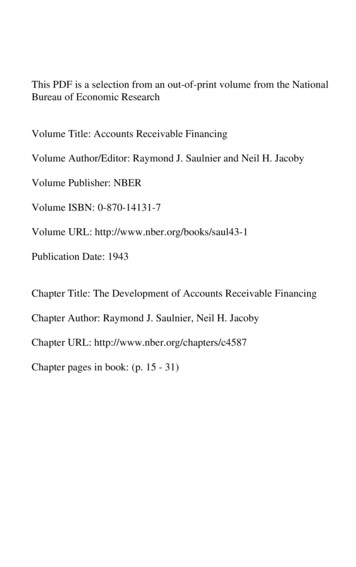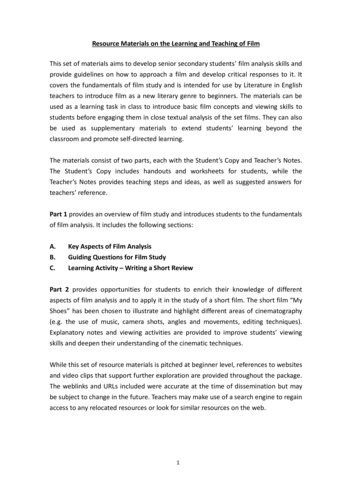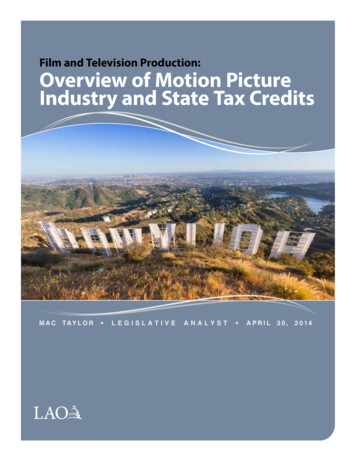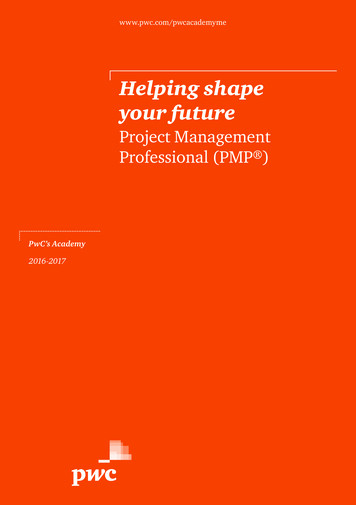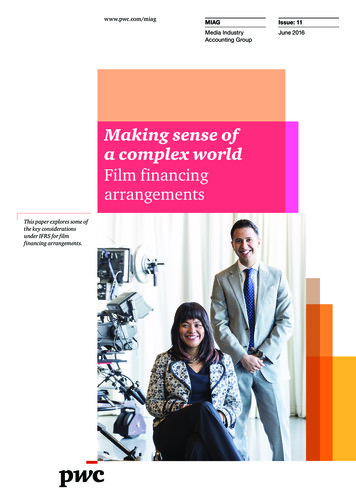
Transcription
www.pwc.com/miagMIAGIssue: 11Media IndustryAccounting GroupJune 2016Making sense ofa complex worldFilm financingarrangementsThis paper explores some ofthe key considerationsunder IFRS for filmfinancing arrangements.
ContentsIntroduction to MIAG1Film financing arrangements2Background3Example 1: Should a funding vehicle be consolidated?5Example 2: How is the investor’s interest classified?9Example 3: Contractual arrangements11Conclusion12Publications/further reading13Contacts16
Introduction to MIAGOur Media Industry Accounting Group (MIAG) brings together ourspecialist media knowledge from across our worldwide network.Our aim is to help our clients by addressing and resolving emergingaccounting issues that affect the entertainment and media sector.With more than 4,200 industrydedicated professionals, PwC’s globalentertainment and media (E&M)practice has depth and breadth ofexperience across key industry sectorsincluding: television, film, advertising,publishing, music, internet, video andonline games, radio, sports, businessinformation, amusement parks, casinogaming and more. And just assignificantly, we have aligned our mediapractice around the issues andchallenges that are of utmostimportance to our clients in thesesectors. One such challenge is theincreasing complexity of accounting fortransactions and financial reporting ofresults – complexity that is driven notjust by rapidly changing business modelsbut also by imminent changes to theworld of IFRS accounting.I would encourage you to contact uswith your thoughts and suggestionsabout future topics of debate for theMIAG forum, and very much lookforward to our ongoing conversations.Best wishesSam TomlinsonPwC UKChairman,PwC Media Industry Accounting GroupThrough MIAG, PwC1 aims to worktogether with the E&M industry toaddress and resolve emergingaccounting issues affecting this dynamicsector, through publications such as thisone, as well as conferences and events tofacilitate discussions with your peers.Sam Tomlinson1PwC refers to the PwC network and/or one or more of its member firms, each of which is aseparate legal entity1 MIAGIssue: 11
Film financingThe costs of developing and producing films (and, increasingly,television too) can be significant and the underlying financingstructures to fund this investment can be very complex. Our 11th MIAGpaper explores some of the key considerations under IFRS for filmfinancing arrangements.PwC’s Global entertainment and mediaoutlook 2015-2019 forecasts global filmrevenues to grow at 4.1% annually,reaching US 105 billion in 2019. Stronggrowth will be seen in China and inLatin America, but even global leaderthe US, with one-third of market spendin 2014, will see above-average annualgrowth of 4.6%. But while Hollywoodremains at the heart of film, a trend inthe forecasts for many markets, fromChina to Western Europe, is theincreased significance of local films inboosting country box office revenue.Significant investment is required tofund the films that drive this growth.The film industry – and, increasingly,television too – has a long history ofencouraging outside investment in filmdevelopment and production.The accounting for such film financingarrangements presents challenges suchas whether to consolidate a legal entityset up to channel the film fundingreceived from an outside investor;whether to recognise the investor’sinterest as non-controlling interest ordebt; and how to account for complexcontractual arrangements. Companiesthat are adept at navigating the intricateaccounting and reporting practices cantell their story in a clear and compellingmanner, building public trust in theirperformance with stakeholders such asinvestors, analysts, employees,suppliers, partners and audiences.We hope that you find this paper usefuland welcome your feedback.This paper explores some of the keyconsiderations under IFRS in accountingfor film financing arrangements. Theexamples in our paper are clearly notdesigned to be exhaustive; but they willhopefully provide food for thought forfilm companies when considering howto account for their own film financingarrangements. In addition, we note thatthe accounting for the actual filmdevelopment and production costs iscovered in a separate paper MIAG 10Film cost capitalisation.PwC Media Industry Accounting GroupBest wishesSallie DeyselPwC UKSallie DeyselIssue: 11MIAG2
BackgroundPwC’s Media Industry Accounting Group(MIAG) is our premier forum fordiscussing and resolving emergingaccounting issues that affect theentertainment and media sector – visitour dedicated website:www.pwc.com/miagAt its heart, the film industry is about great content – that is, developing and producing films to capture anaudience that can be monetised through theatrical release or DVD sales and by licensing to distributionchannels such as television or digital platforms. It is the timeless appeal of this content – of great films – thatcontinues to drive film industry growth. PwC’s Global entertainment and media outlook 2015-2019 forecastsglobal film revenues to grow at 4.1% annually, reaching US 105 billion in 2019.Significant investment is required tofund the films that drive this growth.The film industry – and, increasingly,television too – has a long history ofencouraging outside investment in filmdevelopment and production. Theincreasing cost of blockbuster films andhigh-end scripted television, coupledwith disruption to traditionaldistribution channels by entrants such atNetflix and Amazon Prime, hasaccelerated the trend of complex filmfinancing, as have advantageous grantand tax regimes in certain territories.Investment structures often involvemultiple contractual arrangements andsometimes the use of legal entities inwhich investors take equity stakes.The accounting for such film financingarrangements can present at least threekey challenges for the film company: If a separate funding entity is used,should it be consolidated? Should the investor’s interest beclassified as non-controlling interestor debt?3 MIAGIssue: 11 If the funding is via contractualarrangements, has the film companyentered into a service contract and ifso when should it recognise revenue,other income or a contra-expense?Transactions are often complex and caninclude features such as embeddedderivatives or other put and callarrangements that need to be evaluated.Such complexities are outside the scopeof this paper, but companies shouldensure that they have appropriateexpertise in these areas of accountingand valuation, or otherwise seekguidance from auditors and advisors.Financial executives can provide valuableinput in the early stages of developing suchstructures by highlighting the potentialfinancial statement impacts. This willinclude impacts on the film company’s keyperformance indicators such as EBIT, netdebt, return on investment, and so on.How are film financingarrangements often structured?Many film financing arrangements arecharacterised by a low level of involvementby the financial investor in the filmproduction process and the financial andoperating policies of the investee. These‘passive investor’ arrangement can bestructured using either legal entities orcontractual arrangements.In a legal entity structure, the filmcompany and the financial investor fundtheir respective ownership percentagesin the newly established company(e.g. see Figure 2 in Example 1). Thisallows the film company to reduce itsinitial capital outlay by transferring to thefinancial investor some of the risk andrewards of film under/over-performance.
Some film financing arrangements maynot involve use of a legal entity but areinstead structured as a contractualarrangement between the film companyand investor. The mechanics of theoverall cash flows are similar toarrangements involving legal entities.However, in a contractual arrangement,a film company might also sell a portionof the film’s copyright to the investor, asconsidered in this paper in example 3.What are the key accountingconsiderations?Figure 1 sets out some of the keyaccounting considerations under ‘entity’and ‘contractual’ film financingstructures. This paper then goes on toillustrate these considerations usingsome specific examples.Are there any tax implications?Like all MIAG publications this paper isconcerned primarily with accounting,which should be consistent acrosscompanies reporting under IFRS, ratherthan tax, which will vary with eachcountry’s local laws and tax regulations.neutral, since tax is governed by specificrules. But given the complexity of bothtax rules and many film financingarrangements, we would alwaysrecommend consulting with a local taxexpert to determine the possible taxconsequences of such arrangements andthe accounting for them.Many countries have specific taxlegislation relating to film production,such as ‘film tax credits’ to encouragedomestic and international filmproducers to shoot and edit in thatcountry. In such cases, the accountingtreatment adopted for film financingarrangements should in theory be taxFigure 1: Film financing structures – simplified guide to accounting considerationsDoes the structure involve the sale or issuance of securities by a legal entity?YesNoShould the entity be consolidated underIFRS 10? (consider shareholdings and otherinterests and related contractual arrangements)YesNoConsolidate the entitywith the investor’s interestrepresented by either anon-controlling interest ora debt instrument(liability).Consider whether there isjoint control, significantinfluence or if the filmcompany simply holds aminority stake in the entity.Do the contractual arrangements give rise to aliability for the film company?YesRecognise a financialliability.The film company willtreat the entity as a jointoperation, equityaccounted, or financialasset, depending on thespecific circumstances.NoConsider specific rights andobligations of each party. Acontract might be a: Joint arrangement Service contract Cost-sharing agreement Pre-sale of contentlicence Combination of aboveNote: This decision tree is illustrative and does not contemplate all possible film financing scenarios. The specific facts,circumstances, and structure must be analysed each time to determine an appropriate accounting treatment.Issue: 11MIAG4
Example 1: Should a funding vehicle be consolidated?Figure 2 below illustrates a typical film financing arrangement using a legal entity structure.Figure 2: Film financing arrangement – typical legal entity structureFilm companyAFinancialinvestorA75% for cash25% for cash100%BcashProductionsubsidiaryfinished filmNewCodistribution arrangement100%Cnet proceeds (cash)DistributionsubsidiaryA – Film company and financial investor fund their respective ownership percentages in NewCo through cash (capital investment)B–N ewCo acquires a completed film at cost from a wholly owned production subsidiary of the film companyC – Wholly owned distribution subsidiary of the film company has an agreement with NewCo to distribute the film; net proceeds arereturned to NewCo: revenue less distribution fee, marketing, and participations and residuals (i.e. shares of results paid to talent)Consolidating NewCo – what isthe relevant IFRS guidance?Figure 2 illustrates a typical scenario. Ifthe film company and financial investorheld the same class of ordinary shares inNewCo, each with proportionate votingand dividend rights, then a 75%shareholding would be expected to givethe film company control. The film5 MIAGIssue: 11company would consolidate NewCo andthe financial investor’s stake would beclassified as a non-controlling interest.However, in many cases the key rights ofeach investor are set out in contractualarrangements rather than in theshareholders’ agreement and as such,NewCo will be a ‘structured entity’defined in IFRS 12 Disclosure of interestsin other entities as ‘an entity that hasbeen designed so that voting or similarrights are not the dominant factor indeciding who controls the entity, such aswhen any voting rights relate toadministrative tasks only and therelevant activities are directed by meansof contractual arrangements’.
The film company will control (andtherefore consolidate) NewCo if it haspower over its relevant activities andexposure to the variable returns that itcreates. IFRS 10 sets out a framework ofitems to consider in making thisassessment: Purpose and design of the investee; What the relevant activities are; How decisions about those relevantactivities are made; Whether the rights of the investor giveit the current ability to direct therelevant activities; Whether the investor is exposed, or hasrights, to variable returns from theinvestee; and Whether the investor has the ability touse its power over the investee to affectthe amount of the investor’s returns.So the film company might also controlthe NewCo by virtue of the productionand distribution arrangements, whichwill typically ensure that the ‘relevantactivities’ are directed by the filmcompany. In many cases, the financialinvestor does not have any right, director indirect, to make decisions about anyactivity that may directly impact thesuccess and returns from NewCo.ScenarioFilm company FC enters into anarrangement with investor I. FC and Iincorporate NewCo, which issues 60%of its share capital to I and 40% to FC.The funding will be provided in thatratio and proceeds will be distributedsimilarly. NewCo will not have anyactivities or employees of its own asit solely enters into outsourcingarrangements. FC leads the draftingof the contract to be signed by FC,I and NewCo.FC and I can appoint directors inproportion to their shareholding andBoard decisions are made by majoritydecision. NewCo is constituted to fund,develop and commercialise Film X, towhich it will own all rights. The projectplan and budget are agreed in advance.NewCo is required to enter into contractswith FC’s wholly owned subsidiaries,production company P and distributioncompany D. All production decisions (e.g.casting) are devolved to FC, as are alldistribution decisions (e.g. where to focusadvertising spend). These contracts arepriced at arm’s-length.The agreement says the NewCo board isrequired to approve certain keydecisions. However, approval cannot bewithheld unless there is a materialchange to the agreed plan and budgete.g. the original idea for the film isscrapped or the budget is tobe increased by 25%.Issue: 11MIAG6
How does film company FCaccount for its 40% shareholding?NewCo is an IFRS 10 structured entitybecause it is not controlled by votingrights but by the contractualarrangements. While I’s 60%shareholding gives it the ability tocontrol the board of directors, this hasno substantive powers.FC and I jointly set up NewCo, thepurpose of which is to develop andcommercialise film X. FC had theopportunity and expertise at inceptionto lead the drafting of the project planand budget, from which the board doesnot have the power to deviate. Inaddition, the key contracts and decisionsover relevant activities (production andcommercialisation) are devolved to FC.FC is exposed to the variable returns ofNewCo since it is entitled to receive 40%of any profits that the film generates,profits that will be affected by FC’spower to make decisions over relevantactivities. FC therefore controls NewCo.The classification of I’s 60% stake asnon-controlling interest or liabilitywould require careful consideration byFC, based on the contractual clauses inNewCo’s shareholders’ agreement thatset out the ability or obligation todistribute profits. (Refer to example 2below for an example.)Assuming classification of I as noncontrolling interest, FC’s incomestatement might look like this:So in this case FC consolidates NewCosince power is conferred by the contractsand not the equity stake.Investor I pays 60m for a 60% interest in NewCo, which uses P to produce a film costing 83m which generates revenues of 250mover five years:FC presents I as non-controlling interest/ mYear 1Year 2Year 3Year 4Year 5Revenue (theatre, DVDs, licensing, etc.)75.075.050.025.025.0Distribution costs(7.5)(7.5)(5.0)(2.5)(2.5)Marketing costs(50.0)(25.0)(10.0)(10.0)(10.0)Amortisation of film costs ( 83m over 5 ting (loss)/incomeNon-controlling interest (I’s 60%)FC’s net (loss)/incomeWhat might change theassessment?FC might not control NewCo if its board’sdecision making powers were broader, e.g.if the NewCo board could decide to useanother production or distributioncompany, or if key production andcommercialisation decision requiredmajority board approval, or if the board’sveto rights were expanded to cover moresubstantive decisions.Or, if FC’s financial interest was lessthan 20% (including all other interests),it might conclude that it does not havesufficient exposure to variable returnsand, as such, is acting as an agent for I.7 MIAGIssue: 11If FC does not have control, it still needsto assess whether or not it has significantinfluence over NewCo i.e. whether it isan associate requiring equityaccounting. Since it has a shareholdingof more than 20% there is a rebuttablepresumption that it does. If FC were toconclude that it neither controls nor hassignificant influence over NewCo, itwould account for NewCo as a financialinstrument (equity investment).What else might be tricky?In some arrangements, the financialinvestor may have a ‘put right’ or thefilm company may have a ‘call right’ onthe equity shares held by the financialinvestor. Such repurchase features canhave varying and complex implicationsand should be considered carefully.
Issue: 11MIAG8
Example 2: How is the investor’s interest classified?In example 1 above, the film company FCwill need to carefully assess whether thefinancial investor’s interest is moreappropriately classified as non-controllinginterest or debt.The critical factor in this assessment bythe film company is whether NewCo hasan unavoidable contractual obligation tomake payments to I (in which case theinvestor’s interest is debt) or whether it hasdiscretion over making payments (inwhich case, the financial investor is mostlikely a non-controlling interest)The specific facts and circumstanceswould need to be considered in each caseto determine whether the film companyshould classify the financial investor’sinterest as non-controlling interest or debt.How is film financing debtpresented in the incomestatement?If the film company determines that theinvestor’s interest should be classified asdebt, it must then decide if the investor’sshare of the film’s results should bepresented as either interest (because the9 MIAGIssue: 11investor represents a source of capital)or as an operating expense (because theuse of such investors is a cost of makingand distributing the film). In either case,the amount to be recorded would be theexpected return to the investor based onthe film’s forecast results and aneffective interest model.Specific facts and circumstances willneed to be carefully considered todetermine which of the two options –interest expense or operating cost –most accurately reflects the underlyingeconomics of the transactions. If this isa recurring scenario for a film company,the income statement presentation ofsuch amounts is an accounting policychoice that should be disclosed andconsistently applied.What if the film underperforms?As described above, the amountrecorded in the income statement isestimated based on the film’s forecastresults and an effective interest model,such that it accretes up to the actualamount due to be repaid.If it becomes clear the film’sperformance will be disappointing, thedebt liability might need to bedecreted between one period and thenext. The corresponding incomestatement credit will be reversedagainst the same income statementline item as the original cost i.e. aseither interest income or an offsetagainst operating expenses.If a film’s anticipated performancebecomes so bad that no amounts areexpected to be repaid to the investor,the entire debt obligation is written offas an income statement credit. In sucha scenario, the film company shouldalso carefully assess the film asset forpotential impairment. The conduct ofsuch impairment reviews is covered ina separate paper, MIAG 10 Film costcapitalisation.
Issue: 11MIAG10
Example 3: Contractual arrangementsFor contractual arrangementinvolving an investor, what arethe accounting considerations?In many contractual financingarrangements, the investor pays a fixedamount in exchange for a variablereturn, based on how a film performs.For contractual arrangements the keyconsideration is whether or not the filmcompany has a contractual liability torepay any funding (albeit, thoserepayments might only be made if thefilm is successful). This is more likely tobe the case where the investor is afinancial organisation rather thananother media entity.However, it might be the case that thesubstance of a transaction is of a sale ofan interest that might be accounted forunder IAS 18 Revenue (or IFRS 15 in thefuture). This might be more likely if thecounterparty is another media entity.With a non-financial investor, it is morelikely that the substance might be of acollaborative agreement rather than afinancing. These types of arrangementstend to require significant judgement toestablish the best representation ofsubstance and an appropriate incomeattribution model.11 MIAGIssue: 11ScenarioFilm company FC and investor I agree tocollaborate on the production andcommercialisation of a film. No newlegal entity is created. Investor Icommits up to 50m of funding andreceives a percentage of gross cinemareceipts for two years after the film isfirst released. If the film is unsuccessful,investor I might receive backsignificantly less than it has advanced;conversely if the film is highly successfulthen investor I might receive backsignificantly more than its originalinvestment.Investor I has agreed the project planand budget but does not participate inany of the ongoing production orcommercialisation decisions. Filmcompany FC must make best efforts tocomplete and market the film withinbudget.How does film company FCaccount for this arrangement?The arrangement gives rise to afinancial liability in the scope of IAS 32Financial instruments: Presentation. It isnot an executory contract as investor Idoes not have performance obligations.The amount and timing of payment iscontingent on the occurrence of futureevents that are outside the direct controlof either party. The cash received isrecorded as a liability. The liability issubsequently remeasured at eachreporting date under IAS 39 Financialinstruments: recognition andmeasurement.Do presale arrangements withother distributors and producersrepresent film financingarrangements withfinancial investors?In a presale arrangement, a filmcompany licenses the rights for certainmarkets or territories to another entitythat will exploit those rights in thelicensed market or territory in exchangefor a fixed up-front payment. In manycases, these arrangements should beaccounted for under IAS 18 Revenue asdeferred revenue pending actualdelivery of the film. In some cases,particularly if there is collaboration orcost-sharing, the up-front paymentmight also be treated as a deduction inthe film cost.
ConclusionThe costs of developing and producingfilms can be significant and theunderlying financing structures to fundthis investment can be very complex.Companies that are adept at navigatingthe intricate accounting and reportingpractices can tell their story in a clearand compelling manner, building publictrust in their performance withstakeholders such as investors, analysts,employees, suppliers, partners andaudiences.The answers for complicated real lifearrangements will depend on thespecific facts and circumstances in eachcase. Where transactions are significant,management should include disclosuresin the financial statements that enableusers to understand the conclusionsreached. As always, planning ahead canprevent painful surprises.This paper has explored some of the keyconsiderations under IFRS in accountingfor film financing arrangements. Theexamples in our paper are clearly notdesigned to be exhaustive; but they willhopefully provide food for thought forfilm companies when considering howto account for their own film financingarrangements.To comment on any of the issueshighlighted in this paper pleasevisit our dedicated websitewww.pwc.com/miag or contactyour local PwC entertainment andmedia specialist.We hope you find this paper useful andwelcome your feedback.Issue: 11MIAG12
Publications/further readingwww.pwc.com/miagMIAGIssue: 3Media IndustryAccounting groupApril 2012www.pwc.com/miagMIAGIssue: 4Media IndustryAccounting groupJune 2012Making sense of acomplex worldAccounting for royaltyarrangements – issuesfor media companiesMaking sense of acomplex worldBroadcast television:Acquired programmingrightsThis paper explores someof the key challenges underIFRS in accounting forroyalty arrangements by bothlicensors and licensees.This paper explores thecritical considerationsunder IFRS relating to therecognition, presentation,amortisation andimpairment of acquiredprogramming rights.EP6-2012-01-23-02 32-SW MIAG Issue 4v7.indd 122/06/2012 17:13:40MIAG Issue: 3MIAG Issue: 4MIAG Issue: 5Broadcast television: Acquiredprogramming rightsAccounting for royalty arrangements– issues for media companiesContent development and costcapitalisation by media companiesThis paper explores the criticalconsiderations under IFRS relating tothe recognition, presentation,amortisation and impairment ofacquired programming rights.This paper explores some of the keyconsiderations under IFRS inaccounting for royalty arrangements byboth licensors and licensees.This paper explores the criticalconsiderations relating to theclassification, capitalisation andamortisation of content developmentspend under the applicable IFRSstandards IAS 2 Inventories and IAS 38Intangible Assets, focusing on thetelevision production, educationalpublishing and video game sectors.13 MIAGIssue: 11
www.pwc.com/miagMIAGIssue: 7Media IndustryAccounting GroupMay 2014www.pwc.com/miagMaking sense of acomplex worldRevenue recognition:payments tocustomers – issues formedia companiesThis paper exploressome of the key IFRSaccounting considerationsfor payments by mediacompanies to theircustomers.MIAGIssue: 8Media IndustryAccounting GroupMay 2015Making sense of acomplex worldOnline gaming: Realissues in virtual worldsThis paper explores someof the key IFRS revenuerecognition issues in theworld of online gaming.MIAG Issue: 6MIAG Issue: 7MIAG Issue: 8Revenue recognition: principal/agentarrangements – issues formedia companiesRevenue recognition: payments tocustomers – issues formedia companiesOnline gaming: Real issues invirtual worldsThis paper considers the assessmentof the key principal/agentconsiderations in various practicalexamples, covering physical books,eBooks, television content andfilm production.This paper explores some of the keyIFRS accounting considerations forpayments by media companies to theircustomers, covering the purchase ofadvertising space, physical and digital‘slotting fees’, outsourced advertisingsales and video game prizes.This paper explores some of the keyIFRS revenue recognition issues in theworld of online gaming, coveringprincipal/agent considerations, virtualitems and virtual currencies, andmultiple element arrangements.Issue: 11MIAG14
www.pwc.com/miagMIAGIssue: 9Media IndustryAccounting GroupJune 2015www.pwc.com/miagMaking sense ofa complex worldMedia investmentsin technologycompaniesThis paper explores some ofthe key IFRS accountingissues that can arise whenmaking investments intechnology companies.MIAGIssue: 10Media IndustryAccounting GroupMay 2016Making sense of acomplex worldFilm cost capitalisation,amortisation andimpairmentThis paper explores some ofthe key considerationsunder IFRS for film costcapitalisation, amortisationand impairment.MIAG Issue: 9MIAG Issue: 10Media investments intechnology companiesFilm cost capitalisation, amortisationand impairment.This paper explores some of the keyIFRS accounting issues that can arisewhen making investments intechnology companies.This paper explores some of the keyconsiderations under IFRS for film costcapitalisation, amortisationand impairment.15 MIAGIssue: 11
ContactsGlobal leaderAustraliaMexicoUK leaderBrazilNetherlandsMIAG leaderCanadaRussiaChinaSingaporeFranceSouth AfricaGermanySpainHong KongSwitzerlandIndiaUnited KingdomItalyUnited StatesDeborah Bothundeborah.k.bothun@pwc.com 1 646 471 9048Phil Stokesphil.stokes@uk.pwc.com 44 20 7804 4072Sam Tomlinsonsam.tomlinson@uk.pwc.com 44 20 7804 0726Rosalie Wilkierosalie.wilkie@au.pwc.com 61 2 8266 8381Estela Vieiraestela.vieira@br.pwc.com 55 11 3674 3802Lisa J. Coulmanlisa.j.coulman@ca.pwc.com 1 416 869 8685Wilson Chowwilson.wy.chow@cn.pwc.com 86 755 8261 8886Richard Bejotrichard.bejot@fr.pwc.com 33 1 5657 6039Christoph Grusschristoph.gruss@de.pwc.com 49 69 9585 3415Cecilia Yaucecilia.yau@hk.pwc.com 852 2289 1385Smita Jhasmita.jha@in.pwc.com 91 98 1114 1190Andrea Samajaandrea.samaja@it.pwc.com 39 2 6672 0555JapanMiguel Arrietajose.miguel.arrieta@mx.pwc.com 55 5263 6000 Ext 5857Ennel van Eedenennel.van.eeden@nl.pwc.com 31 88792 4540Natalia Yakovlevanatalia.yakovleva@ru.pwc.com 7 495 967 6395Charlotte Hsucharlotte.hsu@sg.pwc.com 65 6236 7668Vicky Myburghvicky.myburgh@za.pwc.com 27 11 797 4305Inmaculada Izarrainmaculada.izarra@es.pwc.com 34 915 68 5176Patrick Balkanyipatrick.balkanyi@ch.pwc.com 41 587 922 676Sallie Deyselsallie.deysel@uk.pwc.com 44 20 7212 5845Bob BarrettNew Yorkbob.barrett@us.pwc.com 1 703 283 7040Hideaki Zenbahideaki.zenba@jp.pwc.com 81 80 3158 6368Issue: 11MIAG16
This publication has been prepared for general guidance on matters of interest only, and does not constitute professional advice. You should not act u
The film industry – and, increasingly, television too – has a long history of encouraging outside investment in film development and production. The accounting for such film financing arrangements presents challenges such as whether to consolidate a legal entity set up to channel the
